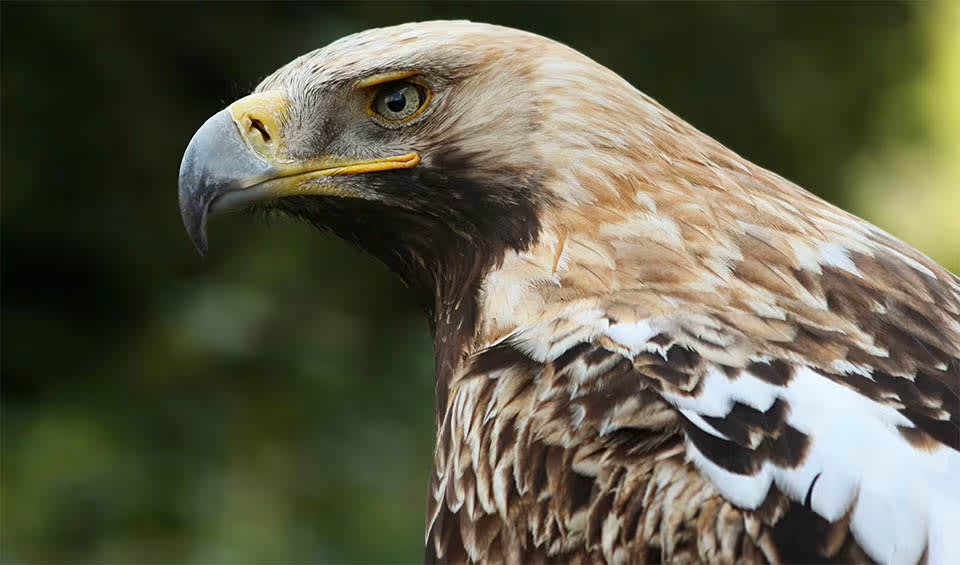A majestic and formidable bird of prey known for its impressive size and regal bearing, the eagle boasts a striking appearance with its dark brown feathers, contrasted by lighter golden-brown plumage on its head and neck. This gives the eagle a crown-like effect, enhancing its imperial stature.
Eastern Imperial Eagles are apex predators in their ecosystems, primarily feeding on medium-sized mammals such as hares and squirrels, as well as a variety of birds and reptiles. They are known for their hunting prowess, utilizing their sharp talons and powerful build to capture and subdue their prey. These eagles are also opportunistic feeders and can adapt their diet based on the availability of food sources, which is crucial for their survival in the varied habitats they occupy, from woodlands and forest edges to grasslands and agricultural fields.
One of the most remarkable aspects of the Eastern Imperial Eagle’s behavior is its nesting habits. They build large and robust nests, primarily in tall trees but occasionally on cliffs, where they return year after year. These nests are constructed from branches and lined with grass and feathers, growing larger with each breeding season as they continue to add materials. The eagles exhibit a strong fidelity to their nesting sites, which is significant for conservation efforts as it makes protecting these areas more feasible.
Eastern Imperial Eagles are migratory birds, with many traveling from their breeding grounds in Eastern Europe and Russia to wintering areas in the Middle East and South Asia. This migration is critical as it allows them to exploit different ecological niches and access food resources that are not available in their breeding areas during the winter months.
Distribution
 Afghanistan
Afghanistan Armenia
Armenia Austria
Austria Azerbaijan
Azerbaijan Bangladesh
Bangladesh Belarus
Belarus Bhutan
Bhutan Bosnia And Herz.
Bosnia And Herz. Bulgaria
Bulgaria Cambodia
Cambodia Cameroon
Cameroon China
China Croatia
Croatia Cyprus
Cyprus Czechia
Czechia Denmark
Denmark Djibouti
Djibouti Egypt
Egypt Eritrea
Eritrea Ethiopia
Ethiopia Finland
Finland France
France Georgia
Georgia Germany
Germany Greece
Greece Hong Kong
Hong Kong Hungary
Hungary India
India Iran
Iran Iraq
Iraq Israel
Israel Italy
Italy Japan
Japan Jordan
Jordan Kazakhstan
Kazakhstan Kenya
Kenya Korea
Korea Kuwait
Kuwait Kyrgyzstan
Kyrgyzstan Laos
Laos Lebanon
Lebanon Libya
Libya Lithuania
Lithuania Macao
Macao Malaysia
Malaysia Moldova
Moldova Mongolia
Mongolia Montenegro
Montenegro Morocco
Morocco Myanmar
Myanmar Nepal
Nepal North Korea
North Korea North Macedonia
North Macedonia Oman
Oman Pakistan
Pakistan Poland
Poland Qatar
Qatar Romania
Romania Russia
Russia Saudi Arabia
Saudi Arabia Serbia
Serbia Singapore
Singapore Slovakia
Slovakia Slovenia
Slovenia Sudan
Sudan Sweden
Sweden Syria
Syria Taiwan
Taiwan Tajikistan
Tajikistan Tanzania
Tanzania Thailand
Thailand Togo
Togo Turkmenistan
Turkmenistan Turkey
Turkey UAE
UAE Ukraine
Ukraine Uzbekistan
Uzbekistan Vietnam
Vietnam Yemen
YemenAnything we've missed?
Help us improve this page by suggesting edits. Glory never dies!
Suggest an editGet to know me
Terrestrial / Aquatic
Altricial / Precocial
Polygamous / Monogamous
Dimorphic (size) / Monomorphic
Active: Diurnal / Nocturnal
Social behavior: Solitary / Pack / Herd
Diet: Carnivore / Herbivore / Omnivore / Piscivorous / Insectivore
Migratory: Yes / No
Domesticated: Yes / No
Dangerous: Yes / No




